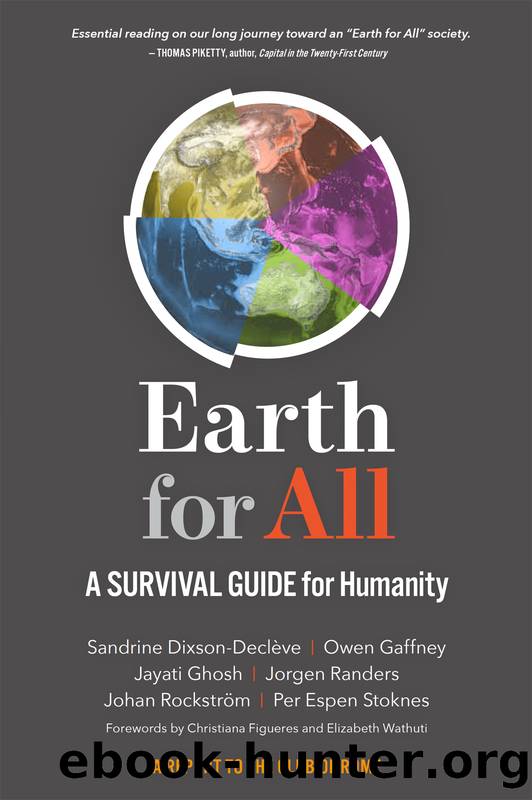Earth for All by unknow

Author:unknow
Language: eng
Format: epub
Publisher: New Society Publishers
Population
Possibly the easiest way to start a long, heated debate is to mention global population growth. Thomas Malthus famously ignited furious arguments 220 years ago. These arguments were still raging in the 1960s when Paul and Anne Ehrlich added fuel to the fire with their bestseller The Population Bomb. They were onto something. In just under fifty years, the global population had almost doubled from 2 billion people to reach 4 billion in around 1975. In 2022, the human population has almost doubled again (7.9 billion people) and growing at around 80 million per year.
So, when will the population double again to 16 billion?
It will not. It will not even get close to this number. In short, the good news is that the âpopulation bombâ that many feared has been defused. The last forty years has seen a huge change in demo graphics. The growth rate peaked in the sixties and has been falling steadily since. Around the world, women are having fewer children. In fact, the average number of children per woman in 2020 was just above two. This hides a large divergence across the world. In places like Japan and South Korea, it is less than two. In low-income countries and in particular in fragile states, the numbers are much higher.
Despite progress on slowing population growth, if the world continues on current trends, the UNâs median population projection sees a peak at around 11 billion people by the end of the century.3 The additional pressure this would put on the Earth system is significant, and it could make or break societies. The UN forecasts this growth to mainly happen in Africa. In some parts of West Africa, births per woman are still as high as six or seven children. Currently, 1.3 billion people live on the continent, and this could double according to the UN median forecast, which we believe is too high. Our model supports our view that the world population will peak around some 9 billion people around 2050.
This, in turn, means we can avoid a perfect storm. Birth rates are connected to many factors including better education, better health, more jobs for girls and women, higher income per person overall, and accessible contraception. All of these lead to more freedom to choose how many children women desire.4 Yet recent data estimates that 222 million women in low-income countries had an unmet need for family planning. Implementing these solutions in sub-Saharan Africa and other low-income countries would avert more than 1 million infant deaths and 54 million unwanted pregnancies that, if not prevented, would result in 21 million inadvertent births, 7 million miscarriages, and 26 million abortions of which 15 million would be unsafe.5 The Giant Leap aims to provide these solutions to help address some of the health and social challenges related to poor family planning provision.
Our analysis indicates that the main actions that make up the empowerment turnaround (education, health, income, pensions) will lead to smaller families, longer lives, and a global population peaking possibly below nine billion people by around 2050.
Download
This site does not store any files on its server. We only index and link to content provided by other sites. Please contact the content providers to delete copyright contents if any and email us, we'll remove relevant links or contents immediately.
Man-made Catastrophes and Risk Information Concealment by Dmitry Chernov & Didier Sornette(5926)
The Revenge of Geography: What the Map Tells Us About Coming Conflicts and the Battle Against Fate by Kaplan Robert D(4037)
Zero Waste Home by Bea Johnson(3782)
COSMOS by Carl Sagan(3559)
Good by S. Walden(3490)
In a Sunburned Country by Bill Bryson(3486)
The Fate of Rome: Climate, Disease, and the End of an Empire (The Princeton History of the Ancient World) by Kyle Harper(3007)
A Wilder Time by William E. Glassley(2818)
Camino Island by John Grisham(2764)
The Ogre by Doug Scott(2635)
Organic Mushroom Farming and Mycoremediation by Tradd Cotter(2631)
Human Dynamics Research in Smart and Connected Communities by Shih-Lung Shaw & Daniel Sui(2466)
Energy Myths and Realities by Vaclav Smil(2441)
The Traveler's Gift by Andy Andrews(2414)
9781803241661-PYTHON FOR ARCGIS PRO by Unknown(2326)
Inside the Middle East by Avi Melamed(2306)
Birds of New Guinea by Pratt Thane K.; Beehler Bruce M.; Anderton John C(2226)
A History of Warfare by John Keegan(2186)
And the Band Played On by Randy Shilts(2132)
